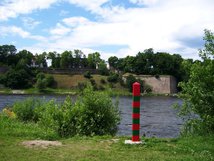Border: Estonia-Russia
Date(s) of establishment: 1920; Current demarcation in 1991Length of border: 294 km
Regions concerned: Estonia – Counties of Ida-Viru, Põlva, Võru
Russia – Oblasts of Leningrad, Pskov, Federal city of St. Petersburg
European programme(s):
- ENPI Programme "Estonia, Latvia, Russia":
Website of the programme
The programme on the Inforegio website - Baltic Sea Region Programme 2007-2013:
Website of the programme
The programme on the Inforegio website
At a length of 294 km, the border between Russia and Estonia begins in the Gulf of Finland. Oriented towards the south, it follows the river Narva and runs alongside Lake Peipsi before coming to an end at the tripoint formed by the Latvian, Russian and Estonian borders.
History
In 1920, following a violent war with the Soviet Union, Estonia obtained its independence. This was ratified by the Treaty of Tartu which also established the border between the two countries.
The military occupation of Estonia by the USSR in 1940 brought about the disappearance of the border. Petseri county and the territory of Ivangorod passed under the control of the USSR.
In 1991, the fall of the USSR enabled Estonia to regain its independence. The border was at this point slightly modified as Russia has conserved the annexed territories, notably at the southern end of the border. The final border agreement was made in 1996.
Cross-border cooperation
With Russia not being a part of the European Union or the Schengen Area, the progress of cross-border cooperation between the countries is measured.
Moreover, modifications to the border have disrupted existing lines of communication. The numerous markers [sentiers] that previously crossed the border have been replaced by several crossing points, such as the “Friendship Bridge” between Narva and Ivangorod. The rarity of these crossing points provokes the congestion of transport infrastructure. To remedy this, an electronic reservation system, which allocates times for crossing the border, was established in 2011.
Today, despite a painful history, there is an established dialogue between Estonia and Russia, with both countries benefiting from a programme funded by the ENPI (European Neighbourhood and Partnership Instrument). The main objective of this programme is to fulfil the potential of the entire border area, in order to attract large amounts of investment for the development of employment, thus increasing prosperity in the region.
Small-scale measures also form part of the programme, with the aim of strengthening ties between inhabitants of the two countries and multiplying the initiatives taken by the local authorities, notably in the fields of culture and sport.
Rich in natural resources, the Russian-Estonian border area also relies on this programme to increase protection of the environment and preserve the cultural heritage of the two countries.
The Russian-Estonian border is also involved with Interreg by way of its participation in the “Baltic Sea” operational programme. This programme aims to make the region more innovative, accessible, attractive, competitive, with respect for the environment (the marine environment in particular).
The cross-border conurbation Narva-Ivangorod is a product of cooperation between Estonia and Russia.
Photo copyright: Rakov


